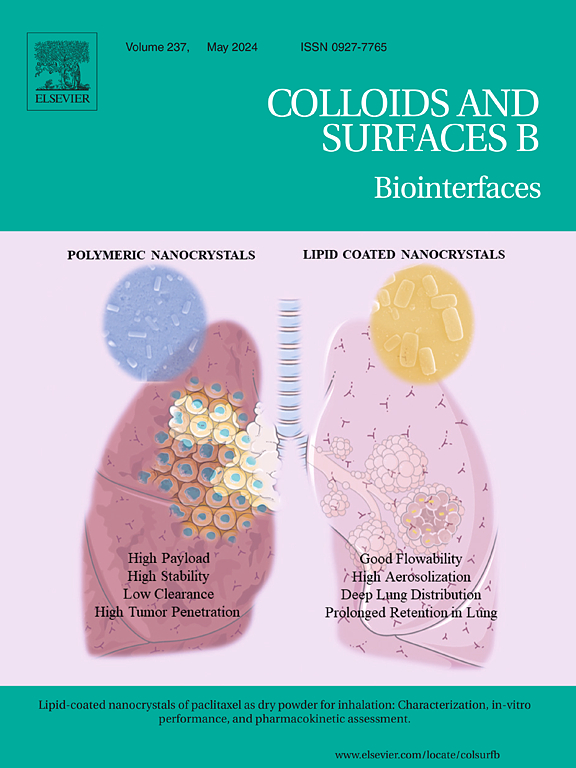胶原/聚吡咯复合膜仿生电微环境调节电极界面神经炎症的研究
IF 5.4
2区 医学
Q1 BIOPHYSICS
引用次数: 0
摘要
与植入神经电极界面星形胶质细胞炎症激活相关的神经炎症是电极失效的主要原因。本研究设计并制备了胶原/聚吡咯复合膜(CPF)来修饰界面。CPF在形态上存在胶原蛋白和聚吡咯的共暴露,使得胶原蛋白提供的仿生微环境能够有效抑制星形胶质细胞的炎症激活。同时,复合膜中的聚吡咯显著提高了电极界面的电化学性能,使其能够提供电微环境,抑制电刺激下星形胶质细胞的炎症激活。此外,机制分析表明,适当的电刺激可以上调钙离子浓度,抑制SOCE和炎症相关信号通路的激活。然而,过电压刺激增加ROS水平并重新激活促炎信号通路。总的来说,得益于胶原生化信号和调节电微环境的能力,CPF使星形胶质细胞在适当的电刺激下具有最低的炎症因子分泌和炎症标志物表达,有效抑制神经炎症的加剧。这项工作为电极界面的抗神经炎症提供了一个新的视角。本文章由计算机程序翻译,如有差异,请以英文原文为准。
Alleviation of neuroinflammation on electrode interface by biomimetic electrical microenvironment modulation based on collagen/polypyrrole composite film
Neuroinflammation associated with inflammatory activation of astrocytes on the interface of implanted neural electrodes is the main cause of electrode failure. In this work, collagen/polypyrrole composite film (CPF) was designed and fabricated to modify the interface. The CPF had the co-exposure of collagen and polypyrrole in morphology, which allowed the biomimetic microenvironment provided by collagen to effectively inhibit the inflammatory activation of astrocytes. Meanwhile, the polypyrrole in the composite film significantly improved the electrochemical performance of the electrode interface, enabling it to provide an electrical microenvironment that inhibited inflammatory activation of astrocytes under electrical stimulation. Moreover, mechanistic analysis showed that appropriate electrical stimulation could upregulate calcium ion concentration while inhibit the activation of SOCE and inflammation-related signaling pathways. However, over-voltage stimulation increased ROS levels and reactivated pro-inflammatory signaling pathways. In general, benefiting from having both collagen biochemical cues and the ability to regulate the electrical microenvironment, CPF enabled astrocytes to have the lowest inflammatory factor secretion and inflammatory marker expression under appropriate electrical stimulation, effectively inhibiting the exacerbation of neuroinflammation. This work provides a new perspective on anti-neuroinflammation of the electrode interfaces.
求助全文
通过发布文献求助,成功后即可免费获取论文全文。
去求助
来源期刊

Colloids and Surfaces B: Biointerfaces
生物-材料科学:生物材料
CiteScore
11.10
自引率
3.40%
发文量
730
审稿时长
42 days
期刊介绍:
Colloids and Surfaces B: Biointerfaces is an international journal devoted to fundamental and applied research on colloid and interfacial phenomena in relation to systems of biological origin, having particular relevance to the medical, pharmaceutical, biotechnological, food and cosmetic fields.
Submissions that: (1) deal solely with biological phenomena and do not describe the physico-chemical or colloid-chemical background and/or mechanism of the phenomena, and (2) deal solely with colloid/interfacial phenomena and do not have appropriate biological content or relevance, are outside the scope of the journal and will not be considered for publication.
The journal publishes regular research papers, reviews, short communications and invited perspective articles, called BioInterface Perspectives. The BioInterface Perspective provide researchers the opportunity to review their own work, as well as provide insight into the work of others that inspired and influenced the author. Regular articles should have a maximum total length of 6,000 words. In addition, a (combined) maximum of 8 normal-sized figures and/or tables is allowed (so for instance 3 tables and 5 figures). For multiple-panel figures each set of two panels equates to one figure. Short communications should not exceed half of the above. It is required to give on the article cover page a short statistical summary of the article listing the total number of words and tables/figures.
 求助内容:
求助内容: 应助结果提醒方式:
应助结果提醒方式:


